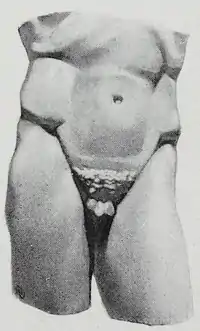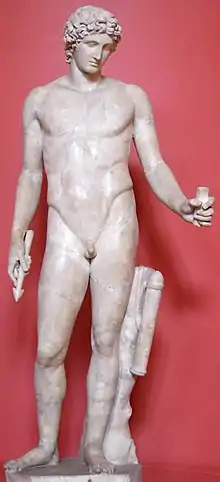Apollo's belt
The Apollo's belt, also known as Adonis belt, or iliac furrows, is a part of the human anatomy referring to the two shallow grooves of the human abdomen running from the iliac crest (hip bone) to the pubis.

Visible Apollo's belt

Apollo (the "Adonis" of Centocelle), Roman after a Greek original (Ashmolean Museum)
The shape of the grooves are formed by the inguinal ligament.[1] The visibility of the belt is caused by a low body fat percentage, rather than the creation of new muscle.[1]
The term "iliac furrow" does not appear in any of the abstracts indexed by PubMed.[2] It is not a currently defined term in Terminologia Anatomica, though it has been used as a formal anatomical term in the past.[3] The term is, however, encountered in modern art history descriptions.[4][5]
References
- "How to get an Adonis belt: Home and gym exercises". Medical News Today. 2017-09-27. Retrieved 2023-08-25.
- "iliac furrow: search results". PubMed. Retrieved 2023-08-25.
- p. 1313
- L. D. Caskey; J. D. Beazley. "78. 01.8020 CUP from Orvieto PLATE XL". Attic Vase Paintings in the Museum of Fine Arts, Boston. Perseus Project. Retrieved 2023-08-25.
- Barbara Hughes Fowler; Warren G. Moon, eds. (1995). Polykleitos, the Doryphoros, and Tradition. University of Wisconsin Press. ISBN 9780299143107.
Look up iliac furrow in Wiktionary, the free dictionary.
This article is issued from Wikipedia. The text is licensed under Creative Commons - Attribution - Sharealike. Additional terms may apply for the media files.